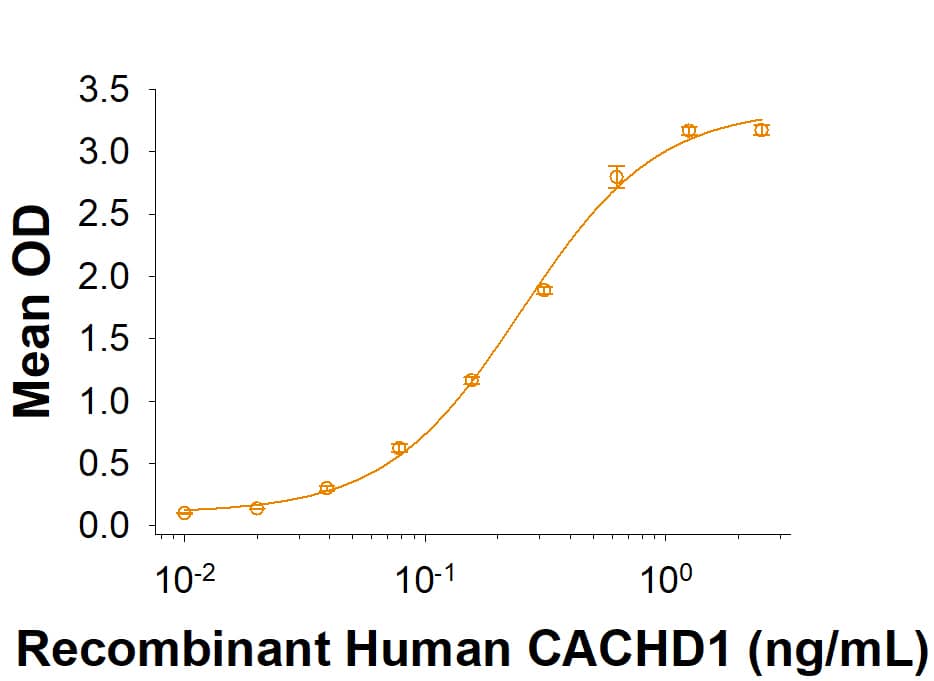Human Teneurin-1 Antibody Summary
Met1-Lys317
Accession # AAF04723
Customers also Viewed
Applications
Please Note: Optimal dilutions should be determined by each laboratory for each application. General Protocols are available in the Technical Information section on our website.
Scientific Data
 View Larger
View Larger
Detection of Human Teneurin‑1 by Western Blot. Western blot shows lysates of IMR-32 human neuroblastoma cell line and HEK293 human embryonic kidney cell line. PVDF Membrane was probed with 1 µg/mL of Human Teneurin-1 Antigen Affinity-purified Polyclonal Antibody (Catalog # AF6324) followed by HRP-conjugated Anti-Sheep IgG Secondary Antibody (Catalog # HAF016). A specific band was detected for Teneurin-1 at approximately 65 kDa (as indicated). This experiment was conducted under reducing conditions and using Immunoblot Buffer Group 8.
Preparation and Storage
- 12 months from date of receipt, -20 to -70 °C as supplied.
- 1 month, 2 to 8 °C under sterile conditions after reconstitution.
- 6 months, -20 to -70 °C under sterile conditions after reconstitution.
Background: Teneurin-1
Teneurin-1 (also Ten-m1, tenascin-M1, and Ten-m/Odz1) is a 250-300 kDa member of the tenascin family, teneurin subfamily of transmembrane (TM) molecules. It is a covalently-linked homodimer that is expressed in both embryonic and adult neurons, among which are cerebellar granule cells and CA2 pyramidal hippocampal neurons. Teneurin 1 appears to promote neurite outgrowth and mediate cell-to-cell adhesion via homophilic interactions. Human Teneurin-1 is a 2725 amino acid (aa) type II TM glycoprotein. It contains a 324 aa cytoplasmic region (aa 1-324) that contains an NLS (aa 62‑65), plus a 2380 aa extracellular domain (ECD). The ECD possesses eight sequential EGF-like domains (aa 528-796), five NHL repeats, each of which form a beta -propeller (aa 1194-1524), and 23 YD/TyrAsp-containing repeats that bind carbohydrates. Cleavage at the N-terminus generates an initial 65 kDa membrane spanning fragment, followed by TM cleavage that generates a 45 kDa cytosolic fragment. C-terminal cleavage generates a short 5 kDa, 41 aa peptide (aa 2682-2722) termed TCAP-1 that shows bioactivity. One splice variant shows a deletion of aa 1232-1239. Over aa 1-317, human Teneurin-1 shares 96% aa identity with mouse Teneurin-1.
Product Datasheets
Citations for Human Teneurin-1 Antibody
R&D Systems personnel manually curate a database that contains references using R&D Systems products. The data collected includes not only links to publications in PubMed, but also provides information about sample types, species, and experimental conditions.
2
Citations: Showing 1 - 2
Filter your results:
Filter by:
-
The Invasion Factor ODZ1 Is Upregulated through an Epidermal Growth Factor Receptor-Induced Pathway in Primary Glioblastoma Cells
Authors: Velasquez, C;Gutierrez, O;Carcelen, M;Fernandez-Luna, JL;
Cells
Species: Human
Sample Types: Cell Lysates
Applications: Western Blot -
ODZ1 allows glioblastoma to sustain invasiveness through a Myc-dependent transcriptional upregulation of RhoA
Oncogene, 2016-09-19;0(0):.
Species: Human
Sample Types: Whole Cells
Applications: Western Blot
FAQs
No product specific FAQs exist for this product, however you may
View all Antibody FAQsIsotype Controls
Reconstitution Buffers
Secondary Antibodies
Reviews for Human Teneurin-1 Antibody
There are currently no reviews for this product. Be the first to review Human Teneurin-1 Antibody and earn rewards!
Have you used Human Teneurin-1 Antibody?
Submit a review and receive an Amazon gift card.
$25/€18/£15/$25CAN/¥75 Yuan/¥2500 Yen for a review with an image
$10/€7/£6/$10 CAD/¥70 Yuan/¥1110 Yen for a review without an image





